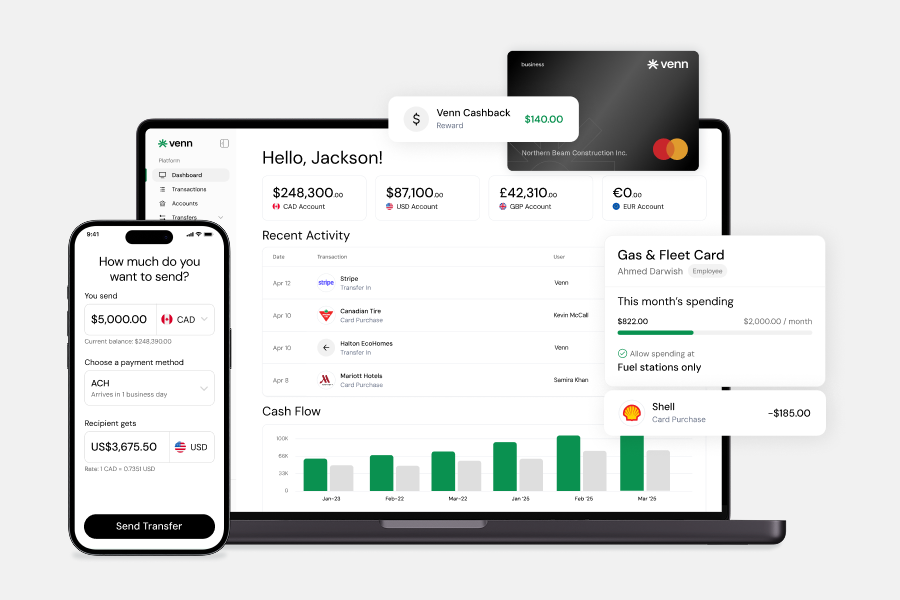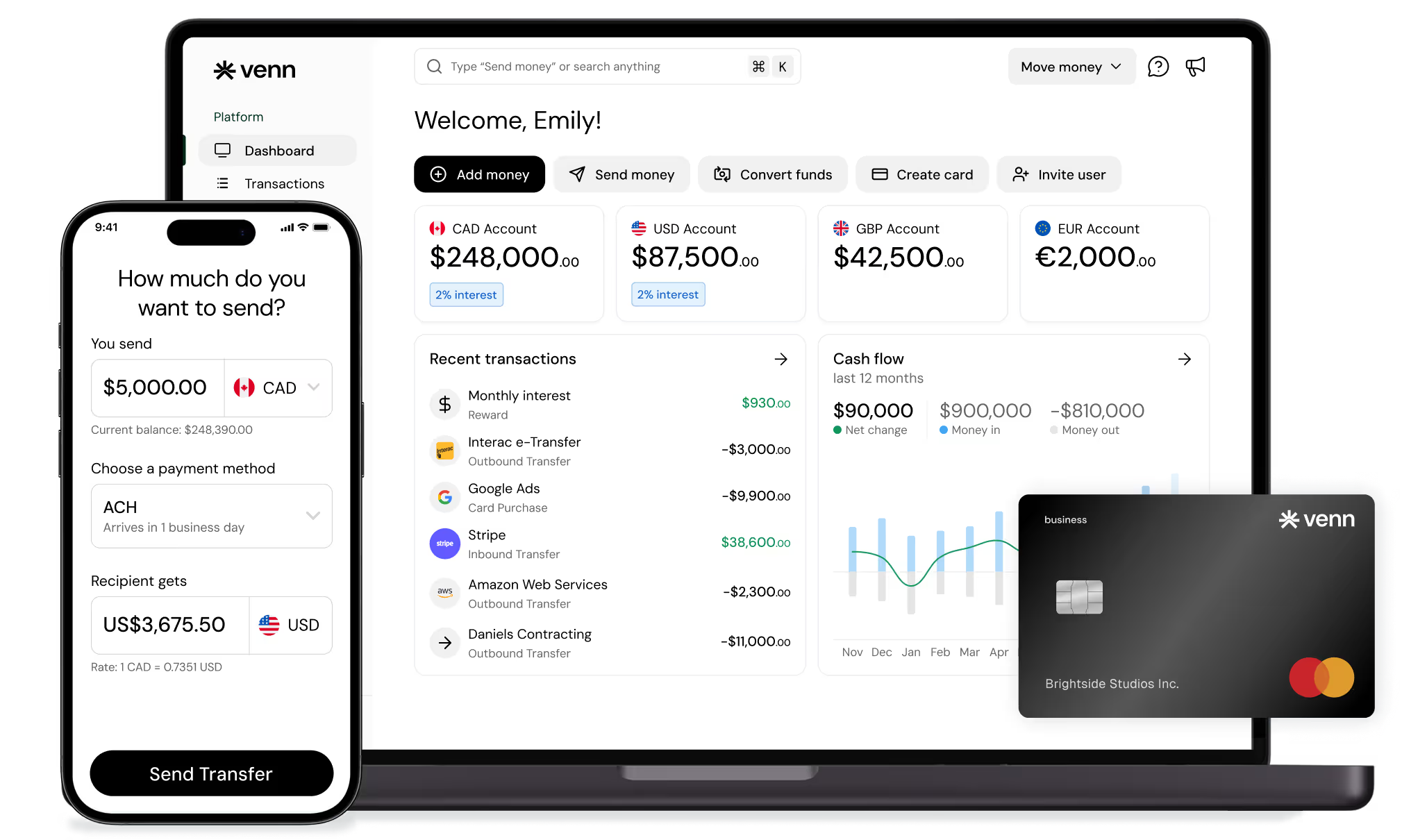How to Prevent Transposition Errors in Your Business Bookkeeping
A transposition error can derail your accounting. Learn what it is, how to detect it, and the best ways to prevent costly financial mistakes.


Trusted by 5,000+ Canadian businesses
Business banking for Canada
Local CAD and USD accounts, corporate cards with cashback, the lowest FX rates in Canada, free local transfers, and more.
Ever failed to catch up with a small typo that made its way into a major financial headache? That is the horrifying reality of transposition errors. They refer to a single-digit swap (typing 27 instead of 72) that can easily throw your account books off track. This type of accounting error causes inaccurate financial records and results in accounting discrepancies.
These mix-ups may seem minor, but they can effectively trigger audit investigations and create a mismatch in totals. These factors make accounting accuracy non-negotiable for compliance and clean reporting.
Why Transposition Errors Are Harmful for Your Business
Minor slip-ups, such as reversing two digits in the accounting records, might seem insignificant. However, transposition errors can create serious problems in your books. When even a small mismatch appears in ledger transactions, you risk miscalculating expenses or income, missing key payments, and filing incorrect tax returns. See common Canadian business tax write‑offs you don’t want misreported.
Worst of all, repeated inaccuracies can harm your hard-earned reputation and invite regulatory scrutiny. This is why preventing transposition errors is important for protecting the foundation of your business. Discover how GAAP principles help ensure accurate financial reporting.
Examples of Transposition Errors in Bookkeeping
- You aim to record $1,050, but end up entering $1,500 - a swap of digits
- You end up switching bank account digits, typing 1324 instead of 1234
These changed entries impact the trial balance accuracy and can distort financial statements to a greater extent. When you spot and correct these mistakes promptly, you reduce reconciliation time, maintain clarity, and ensure accurate cash flow. Read more examples of common transposition errors here.
How to Check for Transposition Errors in Your Business Bookkeeping?
When you spot transposition errors before they appear in your books, it involves some discipline and the right tools.
- A significant step is reconciliation, which involves regularly matching your internal records against bank statements. Not sure what to include on an invoice? Review these essential payment terms.
- Another effective practice is to manually spot-check entries. You should review receipts, invoices, and journal entries to confirm accuracy. Explore how Venn’s invoicing tools simplify accurate invoice management.
- Most finance teams nowadays rely on reliable error-detection software tools that can automatically flag discrepancies. With the help of regular internal audits, you can make sure that your financial data remains audit-ready and protects cash flow from small errors.
With Venn, there is no need to wait until month-end to spot mistakes. Our automated reconciliation feature syncs directly with Xero and QuickBooks, helping to identify and flag mismatches in real-time.
Key Strategies to Prevent Transposition Errors in Bookkeeping
With the right strategies, you can prevent minor issues from escalating into major problems.
1. Double-Check All Transactions
One of the simplest strategies is to double-check every transaction entry. You can perform this manually or utilize automated reconciliation tools. This practice ensures numbers are recorded exactly as intended.
For example, a mistyped invoice number or payment amount could cause an imbalance in your month-end close. It creates a mismatch in totals and affects data integrity. By reviewing entries at the time of posting or scheduling a daily review, you reduce the risk of misstatements that can impact cash flow, taxes, or audits.
Tools like Venn’s two-way sync with QuickBooks and Xero help automate this process, making it easier to catch errors in real-time while reducing manual work.
2. Use Bookkeeping Software with Built-In Error Detection
With manual spreadsheets, there is an increased chance of mistakes, especially related to the occurrence of transposition errors.
Modern bookkeeping software helps catch these mistakes instantly by flagging mismatched data, duplicate entries, or unexplained variances.
For example, platforms that integrate directly with your accounting system can automatically compare transactions against invoices or bank records to surface discrepancies before they snowball.
With Venn, automated reconciliation and error-detection tools do this task for you.
3. Implement Number Formatting Standards
One of the simplest ways to reduce transposition errors is to standardize the presentation of numbers across your records.
For example, always use commas for thousands (e.g., 25,000 vs 25000), decimals for cents, and consistent rounding rules. These small formatting habits prevent confusion during data entry and make errors easier to spot.
4. Use the “Spot the Difference” Method
It involves comparing your recorded amounts (such as invoice entries or ledger figures) line by line with the original documents.
For example, you may have typed $540 instead of $450. This single swap is a classic transposition error. When you train your eye with direct comparisons, you enhance attention to detail. This method helps you intercept mistakes before they grow.
5. Break Down Complex Transactions into Simpler Steps
Complex bookkeeping entries are one of the most common areas where transposition errors occur. Rather than recording a large, multi-part transaction all at once, break it into smaller, clearly defined steps. This makes each entry easier to verify and reduces the likelihood of confusing digits.
For finance teams handling multiple accounts or currencies, simplifying the process also improves audit readiness. With Venn’s customizable dashboards, you can organize transactions into logical categories and steps. This helps you track, review, and reconcile with clarity.
Explore how Venn streamlines bookkeeping to keep your records error-free.
6. Cross-Verify with Bank Statements and Invoices
A simple way to spot transposition errors is to always cross-reference your bookkeeping entries against external documents.
For example, if your ledger shows $2,937, but your bank statement records $2,973, that slight discrepancy could be a transposition error. By comparing line by line, mismatches become apparent quickly. This allows you to spot and correct swapped digits before they turn into larger issues.
7. Train Your Team and Bookkeepers
Ongoing training is one of the most effective ways to reduce bookkeeping mistakes. When employees and bookkeepers regularly refresh their knowledge of best practices. These include double-checking entries, reconciling accounts frequently, and spotting common digit reversals.
For example, short workshops on error detection or refreshers on reconciliation techniques can go a long way in preventing costly transposition errors. Regular training improves accuracy and creates a culture of accountability.
How Venn Helps to Prevent Transposition Errors for Your Business Bookkeeping
To prevent transposition errors, aim to minimize manual data handling. Venn helps with this. With the help of real-time reporting and automated reconciliation, Venn identifies errors as they occur.
Error detection tools catch issues before they become costly mistakes, giving your finance team peace of mind.
For businesses operating across borders, Venn’s built-in multi-currency support ensures transactions are recorded in the correct currency every time. That means no more confusion when dealing with USD, CAD, GBP, or EUR. This helps you avoid common errors in global transactions. Built into these multi-currency accounts are interest on balances, ensuring that your funds aren't sitting idle.
Additionally, Venn’s customizable dashboards provide you with full visibility into every transaction. You can monitor payments, spot irregularities early, and keep your financial reporting on track. The result? Fewer errors, cleaner books, and more confidence in your numbers.
See how Venn can simplify your bookkeeping.

Key Takeaways
- Small mistakes can create significant risks — even a single-digit error can distort financial records, impact tax filings, and trigger compliance issues.
- Prevention is better than correction — consistent checks, standardized formatting, and reliable software reduce the risk of transposition errors.
- Venn makes accuracy effortless — with automated reconciliation, error detection, and multi-currency support, you catch errors in real-time and keep your books audit-ready.
Frequently Asked Questions (FAQs)
Q: Is It Possible to Eliminate All Transposition Errors?
No. While the goal is zero errors, it is difficult to eliminate all transposition mistakes entirely, especially when manual data entry is involved. Transposition errors (swapping digits, e.g., entering $120.00 as $210.00) are almost always human errors that can occur even with the most careful bookkeeping. However, adopting disciplined accounting practices and utilizing automated tools like Venn can significantly minimize their frequency and impact by flagging them instantly.
Q: Can Transposition Errors Affect Tax Filings?
Yes. Transposition errors and other bookkeeping mistakes lead to inaccurate financial statements, which can directly impact your tax filings. Inaccurate tax returns may trigger a review or audit by the Canada Revenue Agency (CRA), potentially resulting in compliance issues, fines, interest charges, or penalties. Using real-time reconciliation and automated reporting tools helps ensure your records are clean and accurate, significantly reducing the risk of a filing mistake.
Q: Can AI or Automation Reduce Transposition Errors in Accounting?
Yes. Automation and AI play a major role in reducing transposition errors by minimizing reliance on manual data entry. Instead of manually typing transactions, platforms like Venn utilize automated bank feeds and real-time, two-way synchronization with accounting platforms (QuickBooks, Xero). This process instantly imports data and uses error-detection features to flag any mismatches or suspicious entries promptly, correcting the mistake before it propagates through your ledgers.
This means that repetitive tasks, such as checking entries against invoices or bank statements, are handled with speed and accuracy.
Venn is all-in-one business banking built for Canada
From free local CAD/USD accounts and team cards to the cheapest FX and global payments—Venn gives Canadian businesses everything they need to move money smarter. Join 5,000+ businesses today.

Frequently asked questions
Everything you need to know about the product and billing.
Venn is the cheapest and easiest way to manage your business banking needs. We offer the best currency exchange rates in Canada, chequing accounts in multiple currencies, domestic and international bank transfers, and a corporate Mastercard to manage all your spend. By signing up to Venn you automatically get:
- Accounts in Canadian dollars, US dollars, British pounds, and Euros
- The cheapest FX rates in Canada with free domestic transfers (EFT, ACH, SEPA, FPS)
- A Mastercard Corporate card that gets you the same great FX rates and cashback with no minimum spend requirements
Yes, Venn holds eligible deposits at our Partner Institution in our trust accounts, including deposits in foreign currencies. CDIC protects eligible deposits up to CA$100,000 per deposit category per CDIC member institution.
No, we don’t have any hidden fees! All charges, including currency conversion and premium plans, are clear and transparent. You can even issue unlimited corporate cards to your team and sign up with a free plan in minutes! Learn more about our transparent Pricing.
Nope! Other companies and traditional bank accounts have high minimum balance requirements. This makes accounts inaccessible for small businesses or individuals. Venn does not require a minimum balance. Your CAD and USD funds will also earn 2% interest regardless of the balance.
Our process is quick — Customers typically get set up in 5 minutes or less! Create a free account and start saving with no monthly fees, cashback on card spend, and the best FX rates around.
Of course! Our friendly Support specialists are available via Chat or Email 24 hours a day, 7 days a week, 365 days a year. All tickets are monitored and responded to within 24 hours, with an average response time of 30 minutes.
Yes, we have a direct integration with QBO and Xero. We are working on more integrations very soon!
Join 5,000+ businesses banking with Venn today
Streamline your business banking and save on your spend and transfers today
No personal credit check or guarantee.


